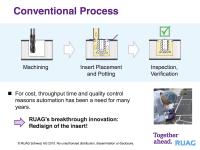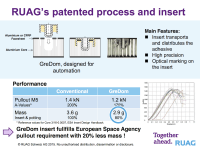With a revolutionary new and patent pending insert, RUAG Space has been able to automate the process of insert placement into composite sandwich panels for satellites. As a result manufacturing time and costs can be reduced significantly. Apart from the above, the new process requires less potting compound to glue the insert into the panel resulting in less launch mass.
In the design of spacecraft structures weight and stiffness are critical design parameters and as a result composite sandwich panels are often used. In one complex satellite sandwich panel more than 800 inserts (to mount equipment) can be found. A typical communication satellite has more than 2500 inserts. Up until now the space industry has been using manual processes to place these inserts.
RUAG’s breakthrough innovation involves the insert itself, the process and a newly developed machine called the RUAG Automated Potting Machine (APM). The machine shapes the panel, drills the insert holes, applies the adhesive to the insert, places the insert into the panel and produces a final test report summarizing the relevant process parameters for each single insert. These activities were previously all done in individual steps on different machines in different locations involving a high amount of manual labor.
What is the value created by the use of automation in your innovation?
Especially for large but also for small satellite panels the space industry is using composite sandwich panels as a standard. The RUAG innovation allows to reduce significantly the throughput time and total cost of composite sandwich panels, whilst at the same it increases flexibility for customers to modify insert patterns late in the process. In addition, the automated process will eliminate the potential for errors linked to manual processes and increase the precision of the insert location.
1. A general rule of thumb in satellite manufacturing is that each month of lead time reduction saves $1.3M. By using the APM the lead time can be reduced by at least one month.
2. A stable automated process with higher accuracies will reduce potential errors and savings can amount of up to $56,000 per satellite structure.
3. Every kilogram to be carried into space costs many thousand dollars; the exact amount depends on factors such as the carrier system and the orbit to be reached. However, six-figure sums and higher are not uncommon.
The vision of RUAG Space is that satellite panel manufacturing becomes a matter of weeks rather than months resulting in related cost savings. The ultimate future goal is that the customer designs and orders the satellite panels guided by RUAG standards in a fully automated process using a web based front-end.
Like this entry?
-
About the Entrant
- Name:Albert Lepore
- Type of entry:teamTeam members:Albert Lepore
Stefan Koegl
Prof. Dr. Hans-Peter Gröbelbauer
Jim Bingen - Patent status:pending








